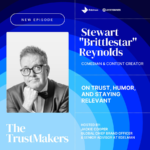By Brett Sirianni, Chief Digital Officer, Inspira Marketing Group
Hold on to your devices because social media’s evolving at breakneck speed in 2024. Not only have platforms like TikTok and Twitch become mainstream, but life has begun to revolve around checking social statuses throughout the day. And these online habits aren’t just limited to younger consumers. Baby Boomers are getting into the act, too. According to Insider Intelligence, the average Boomer now spends upwards of 90 minutes scrolling each day.
As a marketer, you have two choices: Get aboard the most relevant trends or get run over by socially savvy competitors. Assuming you’re going with the former option, let’s look at how you can crush your social media marketing in the new year and pivot your team’s efforts to leverage emerging opportunities.
Rethink what you know about influencers.
Remember when social media influencers were mainly in the beauty and fashion spaces? No longer is this the case. Influencers — especially micro-influencers with small but tight-knit, engaged fan bases — are impacting every industry. This has led the influencer landscape to reach an estimated $21.1 billion in 2023, per Statista.
To grab your piece of this pie, identify micro-influencers within your sector for potential collabs. Be sure to dig deep and find trendsetters whose target audiences, brand voice, and ethics align with your company’s. Don’t feel that you have to set up dozens of partnerships, either. Creating long-term relationships with a few trusted influencers could give your business’s reputation a serious lift, especially if you’re trying to get in front of Gen Z buyers. Hubspot notes that a full third of Gen Z social media users say they rely on influencers to help guide their purchases.
Integrate and blend AI technologies into your social strategies.
AI is making its mark on social media, just as it’s making its mark everywhere. As Mark Zuckerberg reportedly said in 2022, approximately 15% of Facebook and Instagram feeds included recommendations from AI-driven algorithms. At the time, he predicted that the percentage would double by year’s end. This was before ChatGPT hit the scene and changed everything we thought we understood about AI’s content-creation possibilities.
As a brand, you shouldn’t fear taking a hybrid approach to creating tailored social content. For instance, you might want to explore using generative AI to outline your content strategies or even come up with pertinent hybrid-enhanced images. Of course, you don’t want to overlook the authenticity and transparency of this human-bot approach, as 58% of consumers say they want companies to be clear about when AI is being used. Nevertheless, it’s not a bad idea to let AI handle some brainstorming and automated social media responsibilities.
Experiment with augmented reality and voice search.
Augmented reality (AR) offers a completely fresh way for consumers to experience your brand, its people, and its offerings. Though AR was once seen as expensive and daunting, the entry bar has been lowered significantly. For instance, it’s not uncommon for many brands to allow buyers to try on or demo products as part of the discovery, education, and sales process.
Voice search is yet another way to improve AR interactions. Noting that 62% of adults in the United States utilize voice assistants, with 57% engaging in voice commands daily, ensure your social content is optimized for these features. Users who have immersed themselves in an AR activity can ask queries out loud and have questions answered in naturalistic ways. If you’re able to do this without forcing users to move out of the social media platform, you’ll be particularly ahead of the curve.
Keep privacy front and center.
It’s true that consumers want customer-centric engagements with brands. That’s why 82% of consumers are willing to give up some personal information for a better customer experience. However, consumers also want to know that their data is being used and stewarded ethically. If it’s not, 84% are willing to say goodbye and take their business (and their dollars) to a different company.
Although it might not seem like data privacy should be such a huge challenge, it is. You are expected to protect all the insights you obtain, as well as use the results responsibly. Consumers appreciate getting valuable content and personalized treatment, plus the opportunity to opt in or out whenever they want. At the same time, they don’t appreciate feeling like they’re being manipulated or exploited. This is a fine line to walk, but the more you fold ethical considerations into your digital marketing discussions, the better off you’ll be. When you do, you’ll be sure that you’re using your target market’s behaviors, interests, etc., for all the right reasons.
The future of social media couldn’t look brighter for marketers as we ring in 2024. Thanks to all the sophisticated technologies like AI and AR, brands have more creative, reliable, and exciting ways to build real connections with audiences. And the faster you take proactive measures, the better off you’ll be. Chances are strong that we’re just scratching the surface of what social will eventually mean for businesses, buyers, and society at large.
About the Author
Brett Sirianni, Chief Digital Officer at Inspira Marketing, is a supportive leader, strategic thinker and creative storyteller with global marketing experience in apparel, consumer goods, music, entertainment, and media services. He has high-end experience in developing and executing go-to-market plans with expertise in purpose-led brand strategy, social media marketing, digital marketing and e-commerce.











